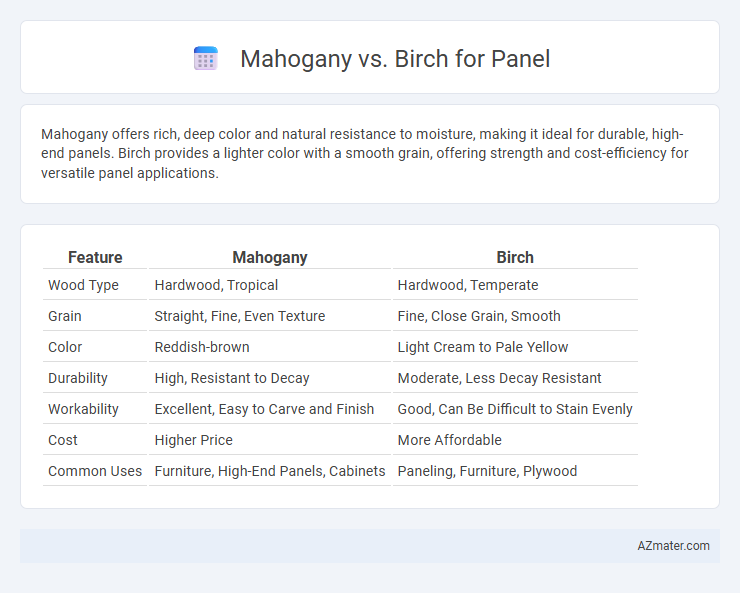Mahogany offers rich, deep color and natural resistance to moisture, making it ideal for durable, high-end panels. Birch provides a lighter color with a smooth grain, offering strength and cost-efficiency for versatile panel applications.
Table of Comparison
| Feature | Mahogany | Birch |
|---|---|---|
| Wood Type | Hardwood, Tropical | Hardwood, Temperate |
| Grain | Straight, Fine, Even Texture | Fine, Close Grain, Smooth |
| Color | Reddish-brown | Light Cream to Pale Yellow |
| Durability | High, Resistant to Decay | Moderate, Less Decay Resistant |
| Workability | Excellent, Easy to Carve and Finish | Good, Can Be Difficult to Stain Evenly |
| Cost | Higher Price | More Affordable |
| Common Uses | Furniture, High-End Panels, Cabinets | Paneling, Furniture, Plywood |
Introduction to Mahogany and Birch Panels
Mahogany panels are prized for their rich, deep reddish-brown color and fine, straight grain, making them ideal for high-end cabinetry and furniture. Birch panels feature a lighter, creamy color with a smooth grain pattern, offering durability and a clean, modern aesthetic. Both woods provide strong structural integrity, but mahogany's natural resistance to decay and birch's affordability distinguish their practical applications in paneling.
Botanical Origins and Wood Characteristics
Mahogany originates from the Swietenia genus, primarily native to Central and South America, known for its rich reddish-brown hue and fine, straight grain which offers durability and resistance to rot. Birch, derived from the Betula genus found mostly in the Northern Hemisphere, features a lighter, cream-colored tone with a smooth, even texture and high strength-to-weight ratio. Both woods vary significantly in density and grain pattern, influencing their aesthetic and functional uses in paneling applications.
Grain Patterns and Aesthetic Appeal
Mahogany features a straight, fine grain pattern with a rich reddish-brown hue that deepens over time, making it a popular choice for luxury panels and elegant furniture. Birch displays a more uniform, tight grain with a lighter, creamy color that offers a clean and modern aesthetic, ideal for minimalist or Scandinavian-style interiors. Both woods provide distinct visual textures, with mahogany lending warmth and depth, while birch delivers brightness and subtle sophistication.
Durability and Lifespan Comparison
Mahogany boasts superior durability due to its dense grain structure, making it highly resistant to decay and insect damage, which extends its lifespan beyond 40 years in indoor applications. Birch, while strong and hard, has a slightly lower resistance to wear and moisture, typically lasting around 20 to 30 years under similar conditions. Choosing mahogany panels ensures enhanced longevity and robustness, ideal for high-traffic or moisture-prone environments compared to birch.
Workability and Ease of Machining
Mahogany offers excellent workability with a fine, straight grain that resists splitting and machines smoothly, making it ideal for intricate panels. Birch, while also easy to machine, tends to be harder and denser, requiring sharper tools and slower feed rates to avoid burn marks and tear-out during panel fabrication. Both woods perform well, but mahogany's consistent texture provides superior ease of machining for detailed and precision panel work.
Color Variations and Finishes
Mahogany panels are prized for their rich, deep reddish-brown hues that darken beautifully with age, offering a luxurious and classic finish ideal for high-end furniture and cabinetry. Birch panels feature a lighter, creamy to pale yellow color palette that provides a versatile base for a wide range of stains and paints, allowing for both natural or contemporary finishes. The fine, uniform grain of birch enhances the smoothness of finishes, while mahogany's interlocking grain lends durability and a lustrous sheen to polished surfaces.
Strength and Stability in Paneling
Mahogany offers superior strength and natural resistance to warping, making it ideal for durable paneling in high-moisture environments. Birch provides excellent stability with a fine, uniform grain that resists cracking and shrinking, ensuring long-lasting structural integrity. Both hardwoods deliver reliable performance, but mahogany's density grants it enhanced impact resistance compared to birch.
Cost and Availability Factors
Mahogany panels generally cost more due to their premium quality and limited availability, often sourced from tropical regions with slower growth rates. Birch panels, on the other hand, offer a more affordable option with better availability, coming from fast-growing, widely distributed hardwood species. Choosing between Mahogany and Birch panels largely depends on budget constraints and the urgency of supply needs for woodworking or furniture projects.
Environmental Impact and Sustainability
Mahogany panels have a higher environmental impact due to slower growth rates and deforestation concerns, whereas birch is considered more sustainable given its faster regrowth and abundance in temperate forests. Birch wood harvesting often supports sustainable forestry practices, reducing carbon footprint and promoting ecosystem balance. Choosing birch panels contributes to eco-conscious construction by minimizing habitat disruption and encouraging responsible resource management.
Best Applications for Mahogany vs. Birch Panels
Mahogany panels excel in luxury furniture, high-end cabinetry, and decorative veneers due to their rich color, fine grain, and durability. Birch panels are ideal for utilitarian applications like shelving, cabinetry, and plywood products, offering a smooth surface and excellent workability at a more affordable price point. Choosing mahogany ensures superior aesthetics and strength for premium projects, while birch provides versatility and cost-efficiency for everyday paneling needs.

Infographic: Mahogany vs Birch for Panel
 azmater.com
azmater.com